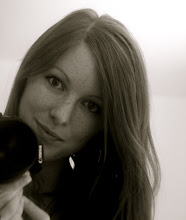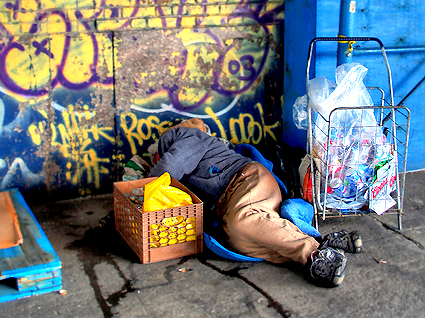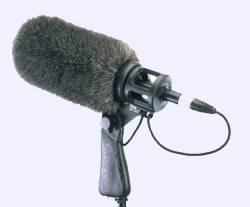The editing process for this took quite a long time to do, but it's finally finished! I edited the final version of
Rough Sleepers using the
Apple editing program
Final Cut Pro, seen below.

The editorial process took a long time to do because of some technical problems with the filming (result of it being the first time I've ever gone and filmed a project by myself!), such as poor audio quality, shaky camera bits, the boom mic being seen in the shot, etc. However, I was able to work around most of these problems to an extent, which took a long time but was worth it in the end. For the shots where the microphone or 'fringe' of the mic on top of the
Panasonic were seen, I was for the most part able to edit these out by cropping the frame and enlarging it to fit the screen. As a result some of the framing isn't ideal, i.e. not enough head room and so on, but definitely better than distracting from the content by seeing what's not meant to be seen!
With the audio quality, the reason why it wasn't the best was because although I looked all over the microphone to try to find a place to set the audio levels before filming, I couldn't find it and assumed there was no way to set the audio levels on that particular microphone. It was only afterward during editing with the help of Rich that I found that there were tiny buttons underneath the battery pack to set the audio levels, but of course by that time it was too late! The result of this was a distinct 'fuzz' or noise during the recording of talking, especially in the interview with Brian which was the most important one.
The way I dealt with this, again with Rich's help, was by sending the project to another
Apple program,
Soundtrack Pro, one that deals specifically with audio (seen below).

After opening the audio tracks, I then had to find a piece of audio that contained only the noise I wanted to remove, select and double-click on it to open a new tab to work on that specific area, then click Process -> Noise Reduction -> Reduce Noise. This then opened a window (seen below right) that allowed me to change the noise threshold percentage (the amount of noise permitted to be heard in the background) as well as the percentage of noise reduction. These had to be balanced against each other as the quality of the sound of the voices needed can be affected by too much noise reduction or not enough noise threshold.


This took a long time as I then needed to go through the project and repeat the same process to every track that needed an audio quality boost. While I wasn't able to cut out the noise completely or bring up the audio quality to just quite the needed level, it did help and made a big difference in the final product.
I was able to use some music that belongs to friends of
James that he had gotten permission from to use under the
Creative Commons Copyright License. This was a huge help and the tracks worked well with how I wanted to put the story across. The first track,
twentyten by the band
Colours, worked particularly well with the
stop-motion opening sequence I used in the beginning, as I was able to edit the pictures to the music in order to pause on a picture of a rough sleeper and make it coincide with a break in the music to give it more dramatic effect.

I used these two tracks as background music throughout the entire film in order to give it more depth and sound, bringing up the music during
B roll footage using the
pen tool to do
key framing to bring the music levels gradually up or down, seen right. The duration of the tracks worked well, as I was able to line up the ending of the second track to the ending of the film with no problem.
After hours putting the project together and trying to figure out ways to provide transitions from one scene to the next without using a narrative or text but allowing the story to speak for itself, I finished the editing of the project and am happy with the result. I decided to end the film and start the credits with the end shot of Brian walking through the restaurant entrance with the door closing behind him. However, I broke up the credits by putting in footage of Brian inside the restaurant and his reaction to sitting in one of Bath's finest restaurants, ending with a shot of Brian eating and then looking up and smiling at the camera. I slowed down the speed to 50% to give it more of a finality and dramatic effect. I then put in a
slug for about 15 seconds and added another extra bit of Brian talking about how he felt being sat in one of Bath's finest restaurants, as well as how much he was looking forward to eating his pudding as it doesn't happen very often! I decided to put this in after the ending to add an extra bit after the viewer thinks that the film has ended, showing a reaction from him that added to the film but wouldn't have fit, in my opinion, with the other shots during the credits as it would have interrupted the music and disrupted the feel of the ending. Since it was filmed inside with low lighting and voices speaking in the background, I felt that it would be better as an unexpected extra bit at the end. This is often done with films after the end credits as an unpredictable addition and one that I felt added to the final project.
Some things I would have done differently in hindsight would have been:
Sound: I would have tried to do everything possible to get a tutorial on the sound equipment
before using it and attempting to figure out how it works on my own, e.g. setting sound recording levels and so on. This would have saved me a lot of time in post production trying to get the sound quality better, which I was never full able to achieve because of the loss in quality of the original sound recording.
Visual: I would have filmed more
B roll footage to have for cutaways during the interviews, as I only had a limited amount which meant having to use much of the same footage for different times in the film. I also needed more footage of the restaurant itself, as I had to use a section from the actual filming of the scene for a cutaway while Josh was talking about the restaurant.
I also would have made sure that the microphone or sound equipment was never in the shot, as if I had done that in the beginning it would have saved a of time in post production cropping and enlarging the frames and making sure they all were the same size in order to make sure that the mic would be out of frame.
Overall, though, I enjoyed the editing process and was happy with the final result. While there are some technical issues to the film, I feel that the main character and the story speaks for itself and allows a glimpse, through Brian's life, to see what it is live as a rough sleeper.
 post production process, I then exported it as a QuickTime .mov file to upload it to my YouTube channel online and to burn it to a DVD using Apple program iDVD. I added and named chapter markers in Final Cut Pro before exporting in order for it to have a DVD menu for scene selection. I also added a slideshow of production stills as another menu selection and added music to the menu options, designing it all using an iDVD template.
post production process, I then exported it as a QuickTime .mov file to upload it to my YouTube channel online and to burn it to a DVD using Apple program iDVD. I added and named chapter markers in Final Cut Pro before exporting in order for it to have a DVD menu for scene selection. I also added a slideshow of production stills as another menu selection and added music to the menu options, designing it all using an iDVD template.














































